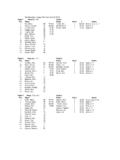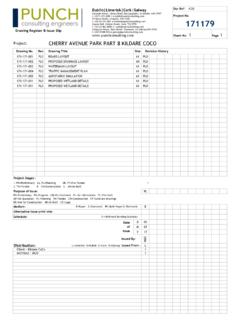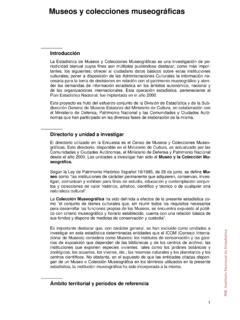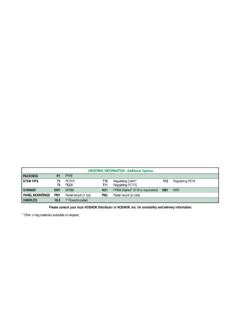Transcription of WHO STEPS Instrument
1 WHO STEPS Instrument (Core and Expanded) The WHO step wise approach to chronic disease risk factor surveillance ( STEPS ) World Health Organization 20 Avenue Appia, 1211 Geneva 27, Switzerland For further information: STEPS Instrument Overview Introduction This is the generic STEPS Instrument which sites/countries will use to develop their tailored Instrument . It contains the: CORE items (unshaded boxes) EXPANDED items (shaded boxes). Core Items The Core items for each section ask questions required to calculate basic variables. For example: current daily smokers mean BMI. Note: All the core questions should be asked, removing core questions will impact the analysis. Expanded items The Expanded items for each section ask more detailed information. Examples include: use of smokeless tobacco sedentary behaviour. Guide to the columns The table below is a brief guide to each of the columns in the Instrument .
2 Column Description Site Tailoring Number This question reference number is designed to help interviewers find their place if interrupted. Renumber the Instrument sequentially once the content has been finalized. Question Each question is to be read to the participants Select sections to use. Add expanded and optional questions as desired. Response This column lists the available response options which the interviewer will be circling or filling in the text boxes. The skip instructions are shown on the right hand side of the responses and should be carefully followed during interviews. Add site specific responses for demographic responses ( C6). Change skip question identifiers from code to question number. Code The column is designed to match data from the Instrument into the data entry tool, data analysis syntax, data book, and fact sheet.
3 This should never be changed or removed. The code is used as a general identifier for the data entry and analysis. Participant Identification Number WHO STEPS Instrument for Chronic Disease Risk Factor Surveillance <insert country/site name> Survey Information Location and Date Response Code 1 Cluster/Centre/Village ID I1 2 Cluster/Centre/Village name I2 3 Interviewer ID I3 4 I4 Date of completion of the Instrument dd mm year Participant Id Number Consent, Interview Language and Name Response Code Yes 1 I5 5 Consent has been read and obtained2 If NO, END No English 1 2 [Add others] [Add others] 3 I6 6 Interview Language [Insert Language]4 [Add others] Time of interview I7 : 7 (24 hour clock) hrs mins Family Surname 8 I8 First Name I9 9 Additional Information that may be helpful I10 10 Contact phone number where possible Record and file identification information (I5 to I10) separately from the completed questionnaire.
4 WHO step wise approach to chronic disease risk factor surveillance- Instrument 5-1-1 Participant Identification Number step 1 Demographic Information CORE: Demographic Information Question Response Code Male 1 C1 11 Sex (Record Male / Female as observed) 2 Female What is your date of birth? C2 12 Don't Know 77 77 7777 If known, Go to C4 dd mm year C3 13 How old are you?
5 Years In total, how many years have you spent at school or in full-time study (excluding pre-school)? C4 Years 14 EXPANDED: Demographic Information No formal schooling 1 Less than primary school 2 Primary school completed 3 Secondary school completed 4 High school completed 5 College/University completed 6 Post graduate degree 7 15 What is the highest level of education you have completed? [INSERT COUNTRY-SPECIFIC CATEGORIES] Refused C5 88 [Locally defined] 1 [Locally defined] 2 [Locally defined] 3 16 What is your [insert relevant ethnic group / racial group / cultural subgroup / others] background? Refused C6 88 Never married 1 Currently married 2 Separated 3 Divorced 4 Widowed 5 Cohabitating 6 17 What is your marital status? Refused C7 88 Government employee 1 Non-government employee 2 Self-employed 3 Non-paid 4 Student 5 Homemaker 6 Retired 7 Unemployed (able to work) 8 Unemployed (unable to work) 9 18 Which of the following best describes your main work status over the past 12 months?
6 [INSERT COUNTRY-SPECIFIC CATEGORIES] (USE SHOWCARD) Refused C8 88 How many people older than 18 years, including C9 19 Number of people yourself, live in your household? WHO step wise approach to chronic disease risk factor surveillance- Instrument 5-1-2 Participant Identification Number EXPANDED: Demographic Information, Continued Question Code Response Per week Go to T1 C10a OR per month Go to T1 C10b OR per year Go to T1 C10c Taking the past year, can you tell me what the average earnings of the household have been?
7 20 (RECORD ONLY ONE, NOT ALL 3) Refused C10d 88 Quintile (Q) 1 1 More than Q 1, Q 2 2 More than Q 2, Q 3 3 More than Q 3, Q 4 4 More than Q 4 5 Don't Know 77 21 If you don t know the amount, can you give an estimate of the annual household income if I read some options to you? Is it [INSERT QUINTILE VALUES IN LOCAL CURRENCY] (READ OPTIONS) Refused C11 88 step 1 Behavioural Measurements CORE: Tobacco Use Now I am going to ask you some questions about various health behaviours. This includes things like smoking, drinking alcohol, eating fruits and vegetables and physical activity. Let's start with tobacco. Question Response Code Yes 1 Do you currently smoke any tobacco products, such as cigarettes, cigars or pipes? (USE SHOWCARD) T1 22 No 2 If No, go to T6 Yes 1 T2 23 Do you currently smoke tobacco products daily? No 2 If No, go to T6 Age (years) How old were you when you first started smoking daily?
8 T3 24 Don t know 77 If Known, go to T5a T4a In Years If Known, go to T5a Do you remember how long ago it was? OR in Months If Known, go to T5a T4b (RECORD ONLY 1, NOT ALL 3) 25 OR in Weeks Don t know 77 T4c T5a Manufactured cigarettes T5b Hand-rolled cigarettes Pipes full of tobacco T5c On average, how many of the following do you smoke each day? Cigars, cheroots, cigarillos T5d 26 (RECORD FOR EACH TYPE, USE SHOWCARD) Other If Other, go to T5other, else go to T9 T5e Don t Know 77 T5other Other (please specify): Go to T9 WHO step wise approach to chronic disease risk factor surveillance- Instrument 5-1-3 Participant Identification Number EXPANDED: Tobacco Use Code Question Response Yes 1 27 In the past, did you ever smoke daily?
9 No T6 2 If No, go to T9 Age (years) 28 How old were you when you stopped smoking daily? T7 Don t Know 77 If Known, go to T9 Years ago If Known, go to T9 T8a OR Months ago If Known, go to T9 T8b How long ago did you stop smoking daily? 29 (RECORD ONLY 1, NOT ALL 3) Don t Know 77 T8c OR Weeks ago Yes 1 30 Do you currently use any smokeless tobacco such as [snuff, chewing tobacco, betel]? (USE SHOWCARD) No T9 2 If No, go to T12 Yes 1 31 Do you currently use smokeless tobacco products daily? No T10 2 If No, go to T12 Snuff, by mouth T11a Snuff, by nose T11b Chewing tobacco T11c Betel, quid T11d Other If Other, go to T11other, else go to T13 T11e On average, how many times a day do you use .. 32 (RECORD FOR EACH TYPE, USE SHOWCARD) Don't Know 77 Other (specify) Go to T13 T11other Yes 1 33 In the past, did you ever use smokeless tobacco such as [snuff, chewing tobacco, or betel] daily?
10 No T12 2 Number of days 34 During the past 7 days, on how many days did someone in your home smoke when you were present? T13 Don't know 77 Number of days 35 During the past 7 days, on how many days did someone smoke in closed areas in your workplace (in the building, in a work area or a specific office) when you were present? T14 Don't know or don't work in a closed area 77 WHO step wise approach to chronic disease risk factor surveillance- Instrument 5-1-4 Participant Identification Number CORE: Alcohol Consumption The next questions ask about the consumption of alcohol.

















